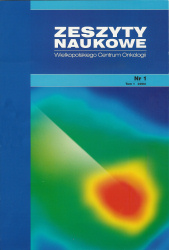Abstrakt
Nowotwory tarczycy są najczęściej występującymi wśród nowotworów układu wewnątrzwydzielniczego. W ciągu ostatnich dekad liczba nowych zachorowań znacząco wzrosła i wciąż wykazuje tendencję wzrostową. U podstaw choroby nowotworowej leżą zmiany zachodzące w komórkach na poziomie molekularnym, głównie mutacje somatyczne
w określonych onkogenach lub genach supresorowych. Analiza profilu molekularnego w zakresie mutacji somatycznych występujących w genach związanych z nowotworami tarczycy pozwala na poszerzenie wiedzy na temat molekularnych podstaw nowotworzenia i poznanie roli ich genetycznego podłoża w rozwoju choroby, jej progresji i rokowaniu powodzenia terapii. Mutacje w genach z rodziny RAS (NRAS, KRAS, HRAS) związane są najczęściej z typem pęcherzykowym nowotworu tarczycy, ale wykrywane są także w przypadku typu anaplastycznego. Mutacje w genie BRAF związane są natomiast z typem brodawkowym, ale również mogą występować w typie anaplastycznym. Mutacje w genie TP53 lub regionie promotorowym genu TERT związane są z większą agresywnością nowotworu, przerzutami i gorszym rokowaniem dla chorego.
Bibliografia
Agrawal, N., et al., Integrated Genomic Characterization of Papillary Thyroid Carcinoma. Cell, 2014. 159(3): p. 676-690.
Lai, X., et al., A meta-analysis of Hashimoto's thyroiditis and papillary thyroid carcinoma risk. Oncotarget, 2017. 8(37): p. 62414-62424.
Resende de Paiva, C., et al., Association between Hashimoto's Thyroiditis and Thyroid Cancer in 64,628 Patients. Frontiers in oncology, 2017. 7: p. 53-53.
Acquaviva, G., et al., Molecular pathology of thyroid tumours of follicular cells: a review of genetic alterations and their clinicopathological relevance. Histopathology, 2018. 72(1): p. 6-31.
Rusinek, D., et al., Coexistence of TERT Promoter Mutations and the BRAF V600E Alteration and Its Impact on Histopathological Features of Papillary Thyroid Carcinoma in a Selected Series of Polish Patients. Int J Mol Sci, 2018. 19(9).
Molinaro, E., et al., Anaplastic thyroid carcinoma: from clinicopathology to genetics and advanced therapies. Nature Reviews Endocrinology, 2017. 13: p. 644.
Tuttle, R.M., B. Haugen, and N.D. Perrier, Updated American Joint Committee on Cancer/Tumor-Node-Metastasis Staging System for Differentiated and Anaplastic Thyroid Cancer (Eighth Edition): What Changed and Why? Thyroid : official journal of the American Thyroid Association, 2017. 27(6): p. 751-756.
Rusinek, D., et al., Current Advances in Thyroid Cancer Management. Are We Ready for the Epidemic Rise of Diagnoses? Int J Mol Sci, 2017. 18(8).
Glaser, S.M., et al., Anaplastic thyroid cancer: Prognostic factors, patterns of care, and overall survival. Head Neck, 2016. 38 Suppl 1: p. E2083-90.
Swierniak, M., et al., Somatic mutation profiling of follicular thyroid cancer by next generation sequencing. Molecular and Cellular Endocrinology, 2016. 433: p. 130-137.
Kunstman, J.W., et al., Characterization of the mutational landscape of anaplastic thyroid cancer via whole-exome sequencing. Hum Mol Genet, 2015. 24(8): p. 2318-29.
Landa, I., et al., Genomic and transcriptomic hallmarks of poorly differentiated and anaplastic thyroid cancers. J Clin Invest, 2016. 126(3): p. 1052-66.
Bonhomme, B., et al., Molecular Pathology of Anaplastic Thyroid Carcinomas: A Retrospective Study of 144 Cases. Thyroid, 2017. 27(5): p. 682-692.
Tiedje, V., et al., NGS based identification of mutational hotspots for targeted therapy in anaplastic thyroid carcinoma. Oncotarget, 2017. 8(26): p. 42613-42620.
Fakhruddin, N., et al., BRAF and NRAS Mutations in Papillary Thyroid Carcinoma and Concordance in BRAF Mutations Between Primary and Corresponding Lymph Node Metastases. Scientific Reports, 2017. 7(1): p. 4666.
Xing, M., Clinical utility of RAS mutations in thyroid cancer: a blurred picture now emerging clearer. BMC Med, 2016. 14: p. 12.
Czarniecka, A., M. Oczko-Wojciechowska, and M. Barczyński, BRAF V600E mutation in prognostication of papillary thyroid cancer (PTC) recurrence. Gland surgery, 2016. 5(5): p. 495-505.
Liu, R. and M. Xing, TERT promoter mutations in thyroid cancer. Endocr Relat Cancer, 2016. 23(3): p. R143-55.
Manzella, L., et al., New Insights in Thyroid Cancer and p53 Family Proteins. International journal of molecular sciences, 2017. 18(6): p. 1325.
Xing, M., Genetic alterations in the phosphatidylinositol-3 kinase/Akt pathway in thyroid cancer. Thyroid : official journal of the American Thyroid Association, 2010. 20(7): p. 697-706.
Xu, B. and R. Ghossein, Genomic Landscape of poorly Differentiated and Anaplastic Thyroid Carcinoma. Endocr Pathol, 2016. 27(3): p. 205-12.
Arighi, E., M.G. Borrello, and H. Sariola, RET tyrosine kinase signaling in development and cancer. Cytokine Growth Factor Rev, 2005. 16(4-5): p. 441-67.
Khan, M.S., et al., RET/PTC Gene Rearrangements in Thyroid Carcinogenesis: Assessment and Clinico-Pathological Correlations. Pathol Oncol Res, 2018.
Armstrong, M.J., et al., PAX8/PPARγ rearrangement in thyroid nodules predicts follicular-pattern carcinomas, in particular the encapsulated follicular variant of papillary carcinoma. Thyroid : official journal of the American Thyroid Association, 2014. 24(9): p. 1369-1374.
